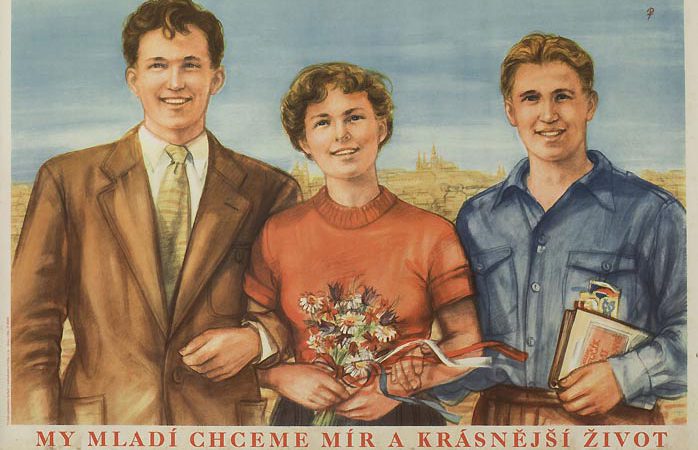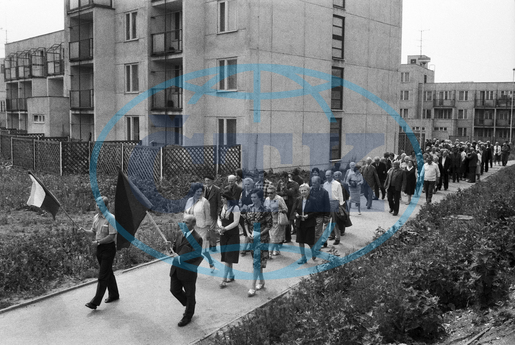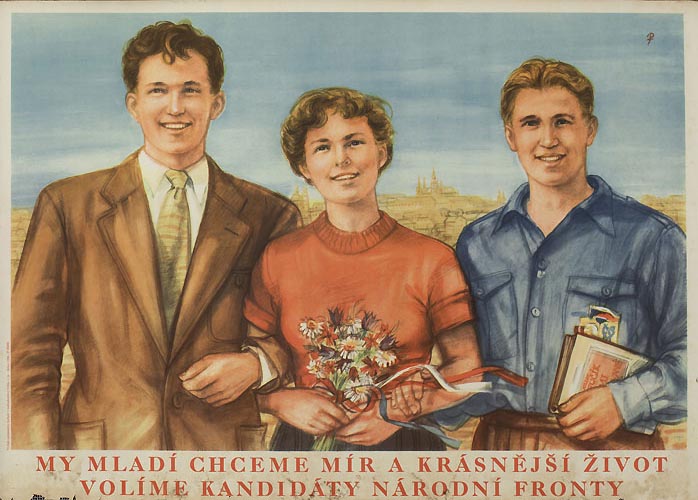
Building Our Lesson Plan: The Election Experience During Czechoslovak State Socialism — Part 2
July 19, 2018To keep the ambiguous meaning of the elections under the state socialism, we will begin our lesson plan with the following introductory photo:

http://multimedia.ctk.cz/foto/document/2079610/41
and ask students to guess what’s going on in it. If students do not know that the lesson is about elections, they might answer, for example: “a funeral, a 1st of May parade, a parade,” or something along those lines. It should become clear that during the socialist era, the elections were accompanied by things that do not happen any more. The question is clear: “Why were these things happening?”
To bring the students’ common experience and perspectives into the class, we proceed with the following image:

http://www.terryhoponozky.cz/plakat/34783-my-mladi-chceme-mir-a-krasnejsi-zivot
This source demands interpretation. It can motivate comparisons with the present day. In this step, it’s important to articulate the values which are usually linked to elections: an orientation towards the future, or the creation of an environment for a better life. The teacher can thus ask questions such as “What values does the poster promote?” or “Who or what do you think the three people in the picture are looking at?”
Having built a foundation of what the elections usually mean and hinted that the Czechoslovak elections differ, we can now approach the essential differences. Many possibilities come forward: we could, for example, show the election outcomes or present some hard electoral propaganda. The following photo, http://multimedia.ctk.cz/foto/index?documentID=2043358&select-continue=1,
depicting a huge Communist party poster hanging over the entrance to a polling place, speaks volumes. As there’s only one electoral option suggested, the „totalitarian character” of the elections is clearly exposed. This photo thus becomes an important step in the dramaturgy of the class, as it deepens students’ feeling of distance and leads them towards an understanding of the main differences between the elections then and now.
In the following step, students are invited to dig deeper into the elections’ period context and meanings. They can either familiarise themselves with the elections‘ role in society, ask why there were any elections held at all if there was only one candidate allowed, or discover their propagandistic and cultural surroundings. We propose various activities for a better understanding of such issues. We can either show students the propagandistic “electoral pop-song” https://www.youtube.com/watch?v=0Z2ux46OKus (34:46-36:00) or let them look at and compare a series of photos http://multimedia.ctk.cz/foto/document/2079641/5
http://multimedia.ctk.cz/foto/document/2079628/6
http://multimedia.ctk.cz/foto/document/2079627/7
http://multimedia.ctk.cz/foto/document/4345584/8
http://multimedia.ctk.cz/foto/document/4345583/9
http://multimedia.ctk.cz/foto/document/2033310/10
http://multimedia.ctk.cz/foto/document/2033303/11.
Both options introduce more informal, everyday aspects of the elections while retaining, and even stressing, their shifted role in society.
To sum up the topic, we propose the following, concluding activity. Students are invited to watch the following film clip: http://www.dejepis21.cz/volby-jako-ritual.
This contemporary movie sketch brings in dynamics from the previous sources and creates a complex image of the elections. Thanks to the acting and the dramatization of the electoral act, students can see the different perspectives of various actors, empathize with them and link them with the previous steps and sources. The ritualized character of the elections with all of their corresponding elements (propagandistic posters and songs, manifestations of unity, the presence of the army, and everything that students have previously noticed) should clearly emerge. To underline the arc that students have just completed, we’ll invite them to return to the first photo. We hope that the image depicted, obscure at the beginning of the class, should be not only clear by the end, but should also show students what knowledge they gained during the lesson.
